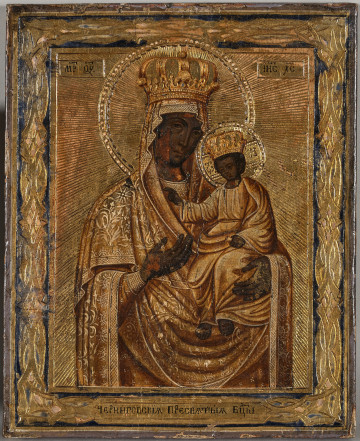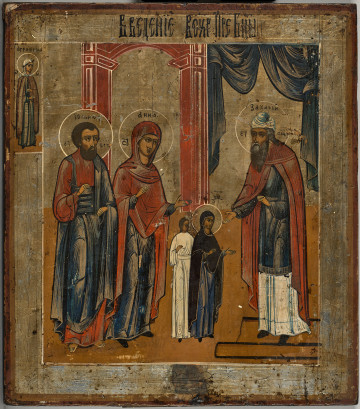
The Mother of God of Hodigitria
19th (?) century
Castle Museum in Łańcut
Part of the collection: Ikony
Crucifixion, silhouette icon. In Rus, cast metal alloy crosses were commonly used. Initially, they were modelled after crafts from Byzantium. Over time, local centres of production and specific local kinds of depictions developed. The most widespread was the eight-pointed cross with three crossbeams (S.12789MŁ – 12795MŁ; S.12869MŁ; S.12871MŁ – 12876MŁ). From the end of the 17th c. until the 20th c., production of cast objects of worship concentrated in the hands of the Old Believers - the adherents of the old Rus Orthodox tradition. They were persecuted as a result of the anathema, or 'exclusion', 'curse', issued against them during the 1666-1667 Great Moscow Synod, when the liturgical reform of the Moscow Orthodox Church was finalised. The Old Believers, who did not accept superficial ornamentation, developed their own types of crafts. They spread and were imitated throughout Russia; and they were used by the adherents of the official doctrine as well. The cross was a special object of worship among the Old Believers; in its cult, an important role was played by identifying inscriptions and prayers accompanying the image of Crucifixion, which were also placed on the back. The communities of Old Believers were not of one mind where the details of the depictions and inscriptions accompanying the Crucifixion were concerned. The Priestless Old Believers, who gave up the service of priests, held views different to those of the Priested communities. In the models developed by the Priested communities, it was allowed to depict the Lord of Hosts - the Old Testament Yahweh Sabaoth - in the crowning and a dove symbolising the Holy Spirit below. In the 'titulus' placed above the head of the condemned Christ, the Priested communities placed the abbreviation 'ІНЦИ', meaning "Jesus of Nazareth, Tsar (King) of Judea", in contrast to the Priestless, who considered such an inscription heretical because it began with Patriarch Nikon's reform. The remaining inscriptions on crosses are discussed under S.12793MŁ. Teresa Bagińska-Żurawska https://orcid.org/0000-0002-9243-3967
Dimensions
height: 12.3 cm, width: 7.2 cm
Object type
Icons
Technique
cast
Material
brass
Origin / acquisition method
decyzja administracyjna
Creation time / dating
Creation / finding place
Owner
Castle Museum in Łańcut
Identification number
Location / status

19th (?) century
Castle Museum in Łańcut

1800 — 1850
Castle Museum in Łańcut

1800 — 1899
Castle Museum in Łańcut
DISCOVER this TOPIC
National Museum in Szczecin
DISCOVER this PATH
Educational path